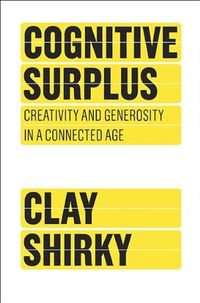
Cognitive Surplus: Creativity and Generosity in a Connected Age
A Psychology, Technology, Nonfiction book. Upgrading one's imagination about what is possible is always a leap of faith. Clay Shirky, Cognitive Surplus: Creativity and Generosity...
The author of the breakout hit Here Comes Everybody reveals how new technology is changing us from consumers to collaborators, unleashing a torrent of creative production that will transform our world. For decades, technology encouraged people to squander their time and intellect as passive consumers. Today, tech has finally caught up with human potential. In Cognitive Surplus, Internet guru Clay Shirky forecasts the thrilling changes we will all enjoy as new digital technology puts our untapped resources of talent and goodwill to use at last. Since we Americans were suburbanized and educated by the postwar boom, we've had a surfeit of intellect, energy, and time-what Shirky calls a cognitive surplus. But this abundance had little impact on the common good because television consumed the lion's share of it-and we consume TV passively, in isolation from one another. Now, for the first time, people are embracing new media that allow us to pool our efforts at vanishingly low cost. The results of this aggregated effort range from mind expanding-reference tools like Wikipedia-to lifesaving-such as Ushahidi.com, which has allowed...
Download or read Cognitive Surplus: Creativity and Generosity in a Connected Age in PDF formats. You may also find other subjects related with Cognitive Surplus: Creativity and Generosity in a Connected Age.
- Filetype: PDF
- Pages: 256 pages
- ISBN: 9781594202537 / 1594202532
r1tTE91CidW.pdf
More About Cognitive Surplus: Creativity and Generosity in a Connected Age
Knowledge, unlike information, is a human characteristic; there can be information no one knows, but there can't be knowledge no one knows. Clay Shirky, Cognitive Surplus: Creativity and Generosity in a Connected Age // The downside of attending to the emotional life of groups is that it can swamp the ability to get anything done; a group can become more concerned with satisfying its members than with achieving its goals. Bion identified several ways that groups can slide into pure emotion - they can become "groups for pairing off," in which members are mainly interested in forming romantic couples or discussing those who form them; they can become dedicated to venerating something, continually praising the object of their affection (fan groups often have this characteristic,... social motivations can drive far more participation than personal motivation alone Clay Shirky, Cognitive Surplus: Creativity and Generosity in a Connected Age //
We live in amazing times. For the majority of those of us who live in America, we have vast reservoirs of free time. But how do we choose to use that free time? Sadly, for the last fifty years, we have spent most of it passively watching television, watching television to the exclusion of other more social, more fulfilling activities.... The main premise that Clay Shirky makes is human beings have moved from a place where they spend most of their free time consuming to a place where we can both produce and consume. It's inspiring to think about the possibilities that collective intelligence provides. Digital technology is making collaboration possible on a large scales... Shirky is one of those educators and social commentators people involved in organizations ignore at their peril. He describes a number of common pitfalls that relate to an old information and media economy and how changes are already here that invite people to connect with each other around what they love, share and produce to different...











